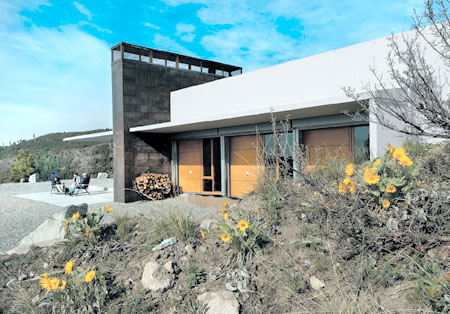
 |
|
Residential Structures |

Photos courtesy of Eggleston Farkas Architects
Nighthawk Retreat’s construction schedule was dictated by its remote location and the area’s short construction season. Its shell was built over a summer and then shuttered for the winter. Interior and finish work resumed the following summer.
Nighthawk Retreat |
|
Location: Eastern Cascade foothills
|
|
Nighthawk Retreat is a V-shaped concrete shell notched into a remote, south-facing mountain ridge. The owners wanted a vacation retreat offering seclusion and connection to the natural environment. The site is off the grid, so solar electrical generation and energy conservation were critical to the success of the project. The roof structure is composed of a 12-inch-thick one-way slab that spans 20 feet and is designed to support up to 4 feet of soil and snow loads of up to 136 pounds per square foot. To contain the rooftop soil, a 5-foot-tall retaining wall was designed near the front of the building, aligning with steel support columns below. Twelve-inch-thick earth-side walls provide retaining, gravity support for the roof and lateral force resistance. Concrete foundations are conventional strip footings combined with a reinforced concrete slab on grade. A large double-wall central fireplace structure acts as a shear wall. Using concrete as the chief material for the roof and retaining walls allowed the house to be an earth-sheltered, passive solar design that offers insulation in the winter and cave-like cooling in the summer. The house relies on the use of concrete as finish material for both its exterior and interior. The underside of the roof slab is exposed as the finished ceiling, and the roof slab, which cantilevers out 7 feet, tapers to 6 inches at the end, providing a visually thin finished edge. Set over the slab on grade and separated by a layer of insulation is a concrete topping slab with hydronic radiant heating, which serves as the finished floor.
|
|
Copyright ©2010
Seattle Daily Journal and DJC.COM. Comments? Questions? Contact us. |